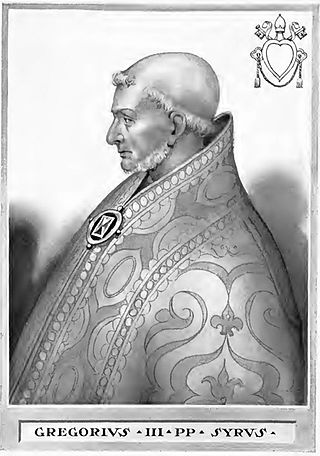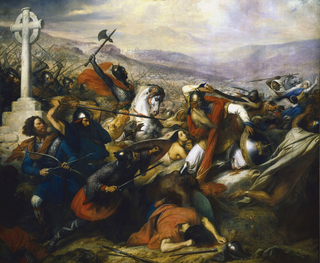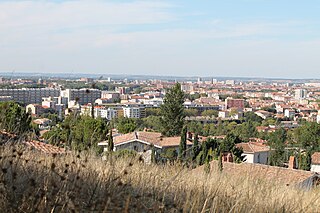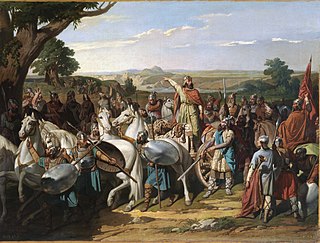
Charles Martel or Charles the Hammer was a Frankish political and military leader who, as Duke and Prince of the Franks and Mayor of the Palace, was the de facto ruler of Francia from 718 until his death. He was a son of the Frankish statesman Pepin of Herstal and Pepin's mistress, a noblewoman named Alpaida. Charles, also known as "The Hammer", successfully asserted his claims to power as successor to his father as the power behind the throne in Frankish politics. Continuing and building on his father's work, he restored centralized government in Francia and began the series of military campaigns that re-established the Franks as the undisputed masters of all Gaul. According to a near-contemporary source, the Liber Historiae Francorum, Charles was "a warrior who was uncommonly ... effective in battle".

Year 731 (DCCXXXI) was a common year starting on Monday of the Julian calendar. The denomination 731 for this year has been used since the early medieval period, when the Anno Domini calendar era became the prevalent method in Europe for naming years.
The 730s decade ran from January 1, 730, to December 31, 739.
The 720s decade ran from January 1, 720, to December 31, 729.
The 710s decade ran from January 1, 710, to December 31, 719.

Year 732 (DCCXXXII) was a leap year starting on Tuesday of the Julian calendar, the 732nd year of the Common Era (CE) and Anno Domini (AD) designations, the 732nd year of the 1st millennium, the 32nd year of the 8th century, and the 3rd year of the 730s decade. The denomination 732 for this year has been used since the early medieval period, when the Anno Domini calendar era became the prevalent method in Europe for naming years.

Year 721 (DCCXXI) was a common year starting on Wednesday of the Julian calendar. The denomination 721 for this year has been used since the early medieval period, when the Anno Domini calendar era became the prevalent method in Europe for naming years.
Year 725 (DCCXXV) was a common year starting on Monday of the Julian calendar. The denomination 725 for this year has been used since the early medieval period, when the Anno Domini calendar era became the prevalent method in Europe for naming years.

Aquitaine, archaic Guyenne or Guienne, is a historical region of southwestern France and a former administrative region of the country. Since 1 January 2016 it has been part of the region of Nouvelle-Aquitaine. It is situated in the southwest corner of Metropolitan France, along the Atlantic Ocean and the Pyrenees mountain range on the border with Spain, and for most of its written history Bordeaux has been a vital port and administrative center. It is composed of the five departments of Dordogne, Lot-et-Garonne, Pyrénées-Atlantiques, Landes and Gironde. Gallia Aquitania was established by the Romans in ancient times and in the Middle Ages, Aquitaine was a kingdom and a duchy, whose boundaries fluctuated considerably.

The Battle of Tours, also called the Battle of Poitiers and the Battle of the Highway of the Martyrs, was fought on 10 October 732, and was an important battle during the Umayyad invasion of Gaul. It resulted in the victory for the Frankish and Aquitanian forces, led by Charles Martel, over the invading Muslim forces of the Umayyad Caliphate, led by Abd al-Rahman al-Ghafiqi, governor of al-Andalus. Several historians, such as Edward Gibbon, have credited the Christian victory in the battle as an important factor in curtailing the Islamization of Western Europe.

Abd al-Rahman ibn Abd Allah Al-Ghafiqi, was an Arab Umayyad commander of the Andalusian Muslims that he unsuccessfully led into battle against the forces of Charles Martel in the Battle of Tours on October 10, 732 A.D.

Septimania is a historical region in modern-day Southern France. It referred to the western part of the Roman province of Gallia Narbonensis that passed to the control of the Visigoths in 462, when Septimania was ceded to their king, Theodoric II. During the Early Middle Ages, the region was variously known as Gallia Narbonensis, Gallia, or Narbonensis. The territory of Septimania roughly corresponds with the modern French former administrative region of Languedoc-Roussillon that merged into the new administrative region of Occitanie. In the Visigothic Kingdom, which became centred on Toledo by the end of the reign of Leovigild, Septimania was both an administrative province of the central royal government and an ecclesiastical province whose metropolitan was the Archbishop of Narbonne. Originally, the Goths may have maintained their hold on the Albigeois, but if so it was conquered by the time of Chilperic I. There is archaeological evidence that some enclaves of Visigothic population remained in Frankish Gaul, near the Septimanian border, after 507.
The history of Toulouse, in Occitania, southern France, traces back to ancient times. After Roman rule, the city was ruled by the Visigoths and Merovingian and Carolingian Franks. Capital of the County of Toulouse during the Middle Ages, today it is the capital of the Midi-Pyrénées region.

The Battle of Toulouse (721) was a victory of an Aquitanian Christian army led by Odo the Great, Duke of Aquitaine over an Umayyad Muslim army besieging the city of Toulouse, led by al-Samh ibn Malik al-Khawlani, the Umayyad wāli (governor-general) of al-Andalus. The decisive Aquitanian victory checked the spread of Umayyad control westward from Narbonne into Aquitaine.
Odo the Great, was the Duke of Aquitaine by 700. His territory included Vasconia in the south-west of Gaul and the Duchy of Aquitaine, a realm extending from the Loire to the Pyrenees, with the capital in Toulouse. He fought the Carolingian Franks and made alliances with the Moors to combat them. He retained this domain until 735. He is remembered for defeating the Umayyads in 721 in the Battle of Toulouse. He was the first to defeat them decisively in Western Europe. The feat earned him the epithet "the Great". He also played a crucial role in the Battle of Tours, working closely with Charles Martel, whose alliance he sought after the Umayyad invasion of what is now southern France in 732.
Uthman ibn Naissa better known as Munuza, was a Berber governor depicted in different contradictory chronicles during the Umayyad conquest of Hispania.

The Muslim conquest of Spain was an invasion of the Iberian Peninsula by the Umayyad Caliphate that occurred from approximately 710 to 780. The conquest resulted in the defeat of the Visigothic Kingdom and the establishment of the Umayyad Wilayah of Al-Andalus.
The siege of Narbonne was fought in 737 between the Arab and Berber Muslim forces of Yusuf ibn Abd al-Rahman al-Fihri, Arab Umayyad Muslim governor of Septimania on behalf of al-Andalus, and the Frankish Christian army led by the Carolingian king Charles Martel.

The Umayyad invasion of Gaul occurred in two phases in 719 and 732 AD. Although the Umayyads secured control of Septimania, their incursions beyond this into the Loire and Rhône valleys failed. By 759 Muslim forces had lost Septimania to the Christian Franks and retreated to Iberia.

The siege of Narbonne took place in France between 752 and 759, led by the Frankish king Pepin the Short against the Umayyad stronghold defended by an Andalusian garrison of Arab and Berber Muslim troops, who had invaded Septimania and occupied the Gothic settlement with its Gallo-Roman inhabitants since 719. The siege remained as a key battlefield in the context of the Carolingian expedition south to Provence and Septimania starting in 752.










